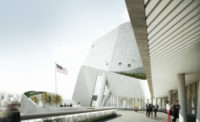Commentary: The New School's Stairmaster


University Center at The New School
SOM
New York City

SOM
New York City

SOM
New York City




The New School, a university that includes the Parsons School of Design, has long operated out of a motley collection of spaces in Manhattan’s Greenwich Village. Hoping to create a campus center, the school proposed building a 350-foot-tall tower on a site has owned since the 1960s, at Fifth Avenue and 14th Street. A tall, tapered building would have enhanced that crossroads. But facing neighborhood opposition, the school scaled back its plans, ending up with a structure that, at 16 stories and 178 feet, is so squat it looks incomplete—inadvertently suggesting that the institution lacks ambition.
The new building, officially called the University Center at The New School, was designed by Roger Duffy, a partner at Skidmore, Owings and Merrill and a leader of its education practice. Duffy chose to cover the $135 million facility in brass panels arrayed in overlapping layers. Alas, the color of the panels is muddy at best. (Duffy calls it chestnut and compares the artificially-weathered, mottled-brown brass to the brick and carved limestone of nearby buildings.) Between its massing and its sheathing, the building diminishes the neighborhood, and possibly the institution it is meant to herald. Duffy, an innovator whose net-zero elementary school on Staten Island is under construction, may have focused more on function than on outward form.
Inside are some spectacular rooms, including a wood-paneled, 800-seat auditorium that will become a popular downtown event space. (The New School is the owner of another auditorium, one of the most beautiful in New York, in its art deco Joseph Urban building at 66-76 West 12th Street.) The most interesting feature of the new building is its stairwells. The facility, containing classrooms, a multi-level library, cafeteria, and 146 dormitory suites on its top nine floors, required multiple fire stairs. It also needed large, open stairways that students could use to get from class to class, and which could serve as gathering places (a la the stairwell in Thom Mayne’s Cooper Union building a few blocks away).
Duffy’s inspiration was to run the fire stairs parallel to the “communicating” stairs, creating the diagonal equivalent of double-decker buses. It remains to be seen how well the system works: Would students, in an emergency, head into the enclosed and presumably smoke-free stairwells, rather than the wider, open, and unsheltered flights? The stairways are articulated behind faceted windows on the building’s north, west, and south facades, producing an effect that some consider dazzling, others, fussy. This critic falls into the latter category, but hopes the students, the real audience for this building, disagree.







